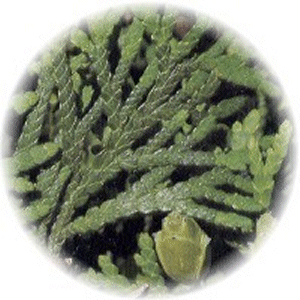

Thuja is a tree reaching 30 to 60 feet tall with horizontal branches and scale-like, green needles. This aromatic evergreen tree has small terminal flowers, which are either dark brown (male) or yellow green (female).
Common Names
History - Ancient peoples burned thuja's aromatic wood along with sacrifices."Thuja" comes from the Latin form of the Greek word thero (to sacrifice). Other species of thuja were used in Egypt for embalming the dead. The botanist Carolus Clusius called the tree arbor vitae, Latin for "tree of life", when he saw one that had been imported from Canada to France. Native Americans used the plant for canoes, baskets, and perfumes, and sometimes boiled twigs for broth when other foods were unavailable or scarce. Oriental thuja, or Platylactus orientalis, has been popular in China for thousands of years, where thuja was cultivated for religious and ornamental purposes.
Native Americans employed thuja for malaria, gout, scurvy, rheumatism, menstrual disorders, and coughs. Thuja's volatile oil acts as a stimulant, a diuretic, and an irritant. Thuja is prepared as an ointment and applied externally to treat joint pain and arthritis. While the parts of the plant usually employed for therapeutic purposes are toxicologically harmless, the compound thujone can be toxic. It can cause vomiting, queasiness, painful diarrhea, and in some cases death.
Thuja is used for respiratory tract infections, and in conjunction with antibiotics, in the treatment of bacterial skin infections and Herpes simplex. Homeopaths safely treat headache, eye inflammation, colds, and warts with thuja. Thuja has an established antiviral activity. Thuja is most often used to treat warts and polyps, being prescribed both internally and externally for these conditions. Thuja is also used as part of a regime for treating cancer -especially cancer of the uterus. Thuja makes an effective expectorant and decongestant remedy, and may be used to treat acute bronchitis and other respiratory infections. Thuja induces menstruation and can be taken to bring on delayed periods, although this use is inadvisable if menstrual pain is severe. Thuja is diuretic and is used to treat acute cystitis and bed-wetting in children. Extracts may be painted on painful joints or muscles as a counter-irritant, improving local blood supply and easing pain and stiffness. Thuja contains 1 % volatile oil including thujone; flavonoid glycoside; mucilage; tannin.
Dosage -